REVIEW: Umarex Walther P.38 Ower Mark Air Pistol

This is a model that replica air gun collectors have been waiting for. The Umarex Walther P.38 is a 20-shot BB pistol with an authentic blowback action. Although not a DA/SA like the original, the all-metal, SA air pistol can deliver its rounds at an impressive velocity of 400 fps. This Umarex air pistol is highly authentic in its appearance, dimensions and original markings. Technically interested owners will like the handling and stripping, which are just like in the original.
This full metal pistol is powered by CO2 and has a removable barrel. The owner's manual shows you how to remove the barrel. Do NOT take any further action than that. Do NOT remove the slide. There's a very long, narrow spring that will quickly and suddenly pop out. If you lose that spring, the gun will not function as intended. The importer does not carry replacement springs if you lose your spring this will not be covered under warranty.
|
Airgun Specifications:
|
Airgun Features:
|
More information about this product.
Additional Umarex Walther P.38 Photos
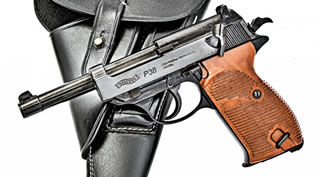
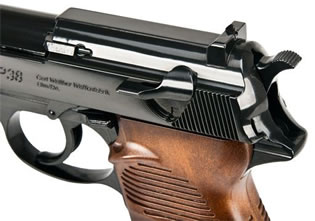
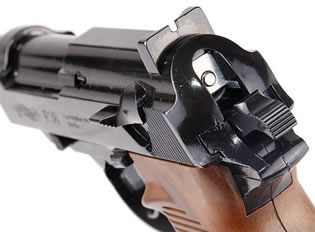
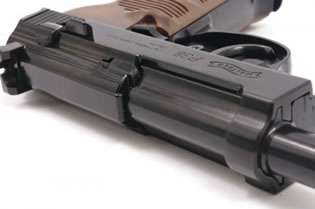
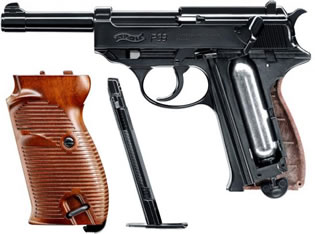
Amazon.com Product and Customer Reviews
Most helpful customer reviews
14 of 14 people found the following review helpful.
![]() Walther P38 Co2 BB Pistol
Walther P38 Co2 BB Pistol
By Sidohne Valerie
The pistol is a kicker. Guaranteed blowback. As accurate as the one firing it. It feels good in the hand, and has that certain Walther P 38 style. However, the users manual is way too skimpy on providing information about the gun itself, it's use and maintenance. A problem I encountered either due to my own ignorance or a minor pistol hiccup was not satisfactorily addressed by the Umarex company. The best they could do when I contacted them by telephone was they had no idea, why don't I send it back to have it checked out, and this was after I thoroughly explained more than once that the hammer was stuck in the open position to the fellow answering the phone from the gun repair service department. After much having to hold the line, so he could consult with his buddy, their collective reply was "Dunno". So, not much help there, to say the least. After that waste of time and effort I decided to telephone a local gun store. I spoke with an employee who easily walked me through a few simple steps, problem solved. The pistol itself is fine, the company that manufactures it could do a lot better in their representation of it. Another thing, the Crossman CO2 cartridge I installed properly leaked initially, but after firing 60 rounds that stopped. The company of course recommends you use their brand of CO2 cartridges, which I think is profit orientated specific to many companies, yet none the less is not very fair nor flexible from a consumers standpoint. Anyway, the pistol itself can't be blamed for that, it delivers a nice bit of firepower, less than the Crossman replica of it, yet in and of itself it's still a gem of a gun.
7 of 7 people found the following review helpful.
![]() Accurate, Reliable, and Realistic.
Accurate, Reliable, and Realistic.
By Amazon Customer
I absolutely LOVE this pistol. The grips are comfortable and look/feel just like real wood, it has good weight to it as well. The blowback actually jerks your wrist upwards a little bit, especially on the first few shots of a new cylinder of air. One cylinder usually gets me between 6 and 7 magazines. Very accurate gun, even when rapid firing. I would recommend this to both beginners and seasoned BB gun users. Pretty much unbeatable for the price.
26 of 27 people found the following review helpful.
![]() Rapid Shipping on a GREAT air pistol!!!
Rapid Shipping on a GREAT air pistol!!!
By Raymond W. Laatz
I live in rual Missouri and fish a lot,there are aggressive poisonous snakes everywhere,what I needed was somethig with the killing power for a snake,but something that wouldn't be dangerous for bystanders if used properly.
As a gun collector I have many great handguns,including a 1918 luger,and a 9mm. Walther P38,This pistol is of the same quality as all the legendary German pistols,I couldn't be happier,this gun is a real firearm,it functions exactly like its' WW2 namesake,it's even spring clip fed,if you buy one of these,You won't be sorry.
History behind the firearm that inspired the Umarex Walther P.38
The Walther P.38 (also known as a Pistole 38) was a semi-automatic pistol that was developed by Walther arms as the service pistol of the Wehrmacht shortly before World War II. It was intended to replace the costly Luger P.08, the production of which was scheduled to end in 1942.
P.38 Development
The first designs submitted to the Heer (German Army) featured a locked breech and a hidden hammer, but the Heer requested that it be redesigned with an external hammer.
The final developmental stage in the P.38's design history was the Modell MP/H (indicating exposed hammer). Apparently only a few were produced before the army adopted the HP in 1938 (Modell Heeres Pistole Model Army Pistol). The production relationship between the HP and the almost simultaneous P.38 (Pistole 1938) is unclear and quite confused.
The P.38 concept was accepted by the German military in 1938 but production of actual prototype ("Test") pistols did not begin until late 1939. Walther began manufacture at their plant in Zella-Mehlis and produced three series of "Test" pistols, designated by a "0" prefix to the serial number. The third series pistols satisfactorily solved the previous problems for the Heer and mass production began in mid-1940.
Early P.38s were almost identical to the HP (which continued to be produced for "commercial sales," i.e., to well-connected Nazis). The major differences were different slide markings, an external extractor, a round firing pin rather than a rectangular one, a different configuration for the locking lever and slide stop lever on the left side, and a re-configuration of the grip panels.
It is interesting to note that in 1944 the cost of one complete P.38 was $14.08, while the cost of one complete P.08 Luger was $19.80. The commercial retail price of the Model HP during this time was $75.
P.38 Design
Several experimental versions were later created in .45 ACP, and .38 Super, but these were never mass-produced. In addition to the 9x19mm Parabellum version, some 7.65x21mm Parabellum and some .22 Long Rifle versions were also manufactured and sold.
From an engineering perspective the P.38 was a semi-automatic pistol design that introduced technical features that are found in other, later, semi-automatic pistols like the Beretta 92 and its M9 sub-variant adopted by the United States military.
The P.38 was the first locked-breech pistol to use a double-action/single-action (DA/SA) trigger (the earlier double-action PPK was an unlocked blowback design, but the more powerful 9x19mm Parabellum round used in the P.38 mandated a locked breech design). The shooter could chamber a round, use the de-cocking lever to safely lower the hammer without firing the round, and carry the weapon loaded. Pulling the trigger cocks the hammer before firing the first shot with double-action operation. The firing mechanism extracts and ejects the first spent round, cocks the hammer, and chambers a fresh round for single-action operation with each subsequent shot - all features found in many modern day handguns. Besides a DA/SA trigger design similar to that of the earlier Walther PPKs the P.38 featured a visible and tactile loaded chamber indicator in the form of a metal rod that protrudes out of the top rear end of the slide when a round is present in the chamber.
P.38 made by Mauser, coded "byf 44" with matching presstoff and leather holster. The moving-barrel design mechanism operates by use of a wedge-shaped falling locking block underneath the breech. When the pistol is fired both the barrel and slide recoil for a short distance together, where the locking block drives down, disengaging the slide and arresting further rearward movement of the barrel. The slide however continues its rearward movement on the frame, ejecting the spent case and cocking the hammer before reaching the end of travel. Two return springs located on either side of the frame and below the slide, having been compressed by the slide's rearward movement, drive the slide forward, stripping a new round from the magazine, driving it into the breech and, in the process, re-engaging the barrel; ending its return travel with a fresh round chambered, hammer cocked and ready to repeat the process. The falling locking block design provides good accuracy due to the in-line travel of the barrel and slide.
Initial production P.38 pistols were fitted with walnut grips, but these were later supplanted by Bakelite grips.
Overall length of the P.38 is 210 mm (8.3 in). The barrel is 125 mm (4.9 in) with a six-groove bore with a 1:10 right-hand twist. The height is 137 mm (5.4 in) and the width, at the grip panels, is 29.5 mm (1.16 in). The empty weight is about 977 g (34.5 oz).
The sights are fixed, front and rear. The rear sight is an open U-notch and the front sight blade is dovetailed to an integral mount on the barrel.
World War II manufacturers
During the early and mid 1990s, large quantities of these wartime pistols captured by the Soviets on the Eastern Front were imported to the United States. All of these pistols had been "dipped," which means reblued without first polishing to remove defects. Most of them, in accordance with the Gun Control Act of 1968, have importers' marks prominently displayed on their barrels, although some do not. Further, these pistols can usually be distinguished by a black oxide finish that's suspiciously consistent on every single one of the components. Most were inspected and re-finished at the Izhevsk Mechanical Plant in Izhevsk, Soviet Union.
Post-World War II P.38s
Postwar Germany, with four occupation zones (American, British, French, and Russian) was strictly controlled with regard to armaments under the Four Powers Agreement. This protocol forbade the German production of weapons, as well as the formation of any German armed forces or centralized police force.
Each of the occupying countries interpreted the agreement to suit its own ends, as evidenced by P.38 production under both French and Soviet authorities. The first armed groups in the four zones were decentralized police organizations armed with an eclectic mix of Allied small arms and German weapons, such as the K98k bolt-action rifle, the Walther PP and PPK pistols, and the P.38.
In the American zone, all captured German weapons were destroyed, except for a few P.38s, and the police units were equipped with the small arms of the U.S. Army. In 1949, the American, British, and French zones were united as the Federal Republic of Germany, and a new military force was authorized and formed in 1956.
By 1957, the P.38 was accepted and World War II-era pistols were cannibalized and rebuilt, with the swastika defaced and the pistols refinished. By the middle of the 1950s, German police units were issued new P.38 pistols with aluminum alloy frames that were manufactured by Walther at Ulm-Donau.
The Walther factory was completely destroyed by the end of World War II, and the Red Army confiscated all of the machinery. Escaping to the west, the Walther family established a modest facility in Ulm-Donau on the Danube River in the early 1950s.
Fritz Walther secured a contract with the newly reestablished Bundeswehr for 100,000 so-called P1 (Pistole 1) in 1954. It was the standard sidearm of the Bundeswehr until at least 1994. Commercial sales commenced in 1957, and production by Manurhin in France also began that year.
Sales of the P1 were also made to Austria, Norway, Portugal, the Republic of South Africa, the Pakistani air force, the army of Ghana, and the armies of Argentina, Canada, Chile, Colombia, Peru, Uruguay, and Venezuela. It was manufactured in 9x19mm Parabellum, 7.65Ãâ€â€21mm Parabellum (.30 Luger), and .22 LR rimfire.
At first, these pistols were manufactured with steel frames, but quickly, a black anodized aluminum alloy frame was introduced into series production. Walther was a pioneer in the development of alloys applied to handgun design.
P.38 Variants
The Walther P.38 was in production from 1938 to 1963. From 1945 to 1957, no P.38s were produced for the German military. Slowly over time, West Germany desired to rebuild its military so that it could shoulder some of the burden for its own defense. Walther retooled for new P.38 production since no military firearms production had occurred in West Germany since the end of the war, knowing that the military would again seek Walther firearms. When the Bundeswehr announced it wanted the P.38 for its official service pistol, Walther readily resumed P.38 production within just two years, using wartime pistols as models and new engineering drawings and machine tools. The first of the new P.38s were delivered to the West German military in June 1957, some 17 years and two months after the pistol had initially seen action in World War II, and from 1957 to 1963 the P.38 was again the standard sidearm.
In late 1963 the postwar military model P1 was adopted for use by the German military, identifiable by the P1 stamping on the slide. The postwar pistols, whether marked as P.38 or P1, have an aluminum frame rather than the steel frame of the original design. The aluminum frame was later reinforced with a hex bolt above the trigger guard.
The last death penalty in Germany was conducted with a variant of the Walther P.38 with a suppressor in East Germany on June 26, 1981. During the 1990s the German military started replacing the P1 with the P8 pistol and finally phased out the P1 in 2004.
An improved version of the P.38, the Walther P4, was developed in the late 1970s and was adopted by the police forces of South Africa, Rhineland-Palatinate and Baden-Werttemberg.
